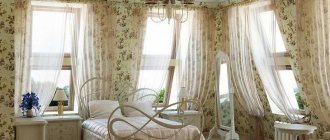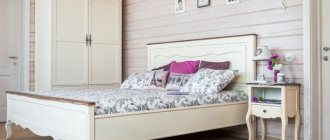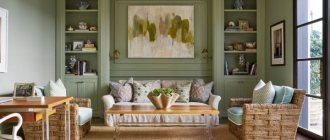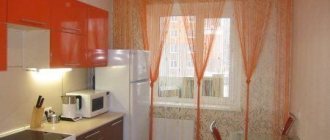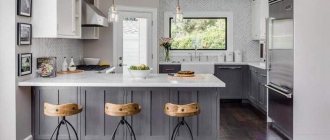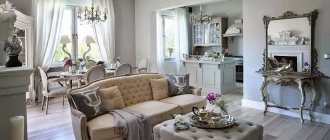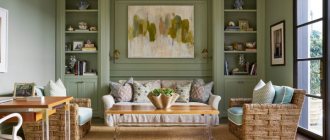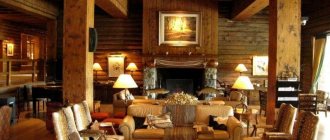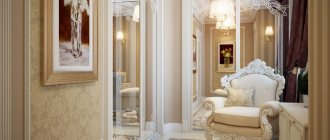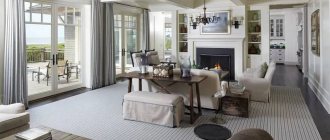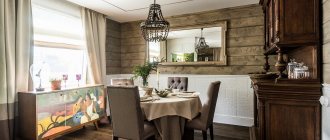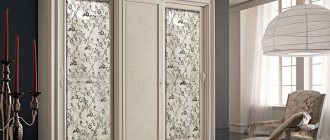Features of Provence
A few characteristic nuances:
- For the Provencal style, it is appropriate to have textiles, furniture upholstery, dishes and decor with floral patterns, as well as decorations in the form of airy lace and macrame.
- The interior is done in pastel and sun-bleached colors with the addition of small bright accents.
- The kitchen is furnished with simple wooden furniture with open shelves and built-in niches.
- In the design it is possible to use unpainted or bleached ceiling beams and available finishing materials in the form of wood, clay, brick or stone with a natural texture.
Style Features
In the 17th century, representatives of French bohemians, intellectuals and industrialists increasingly began to move away from the strict and prim classics and equip their country homes with maximum comfort. A new, more ergonomic and particularly cozy style, called Provence, gradually spread throughout Europe.
Provence style has become popular all over the world
Since it originated in the south of France, this style also began to be called French cantre . The peak of its popularity occurred in the middle of the 19th century - during these years representatives of the majority of the European nobility became its adherents.
The combination of aged elements of rustic life with French elegance gives an amazing effect. At first glance, this style seems unusually simple and unpretentious. Only by looking closely at the details can you see the painstaking work of the designer. There are no flashy elements here - all objects are in perfect harmony with each other, creating a special atmosphere of silence and tranquility.
Combining aged rustic elements with French elegance
Let us briefly list the main features of the style:
- pastel shades with small bright accents: due to the abundance of sun that reigns almost all year round in the south of France, most items look slightly faded;
- simple furniture with built-in niches and open shelves;
- wooden, forged or wicker chairs with woven upholstery, a square or round table;
- unpainted or bleached ceiling beams;
- natural fabrics: linen, cotton with a printed pattern in floral motifs, stripes or checks;
- accessories in the form of antiques or artificially aged objects;
- handmade elements: carving, weaving, painted, wicker, glazed or earthenware, embroidered napkins and tablecloths, bundles of fragrant herbs;
- floors are wooden or made of ceramic, fired clay tiles;
- Natural flowers;
- plenty of light: high windows and doors and a sufficient amount of artificial lighting.
Blue, calm tones
Kitchen furniture and appliances
The kitchen set in the Provence style mainly has an antique and vintage look. The design with a wooden countertop will go perfectly with a white ceramic sink or a sink with copper and bronze faucets.
In the kitchen there are closed cabinets and open shelves that are filled with decorative elements, sets, vases, jars of spices, painted plates and other accessories.
For a Provencal interior, choose light furniture with characteristic scuffs. Doors can be decorated with glass inserts, Tiffany stained glass, panels, carvings, patina or decoupage. An antique grandma's sideboard or a china cabinet with lattice fronts will fit perfectly into this design.
The photo shows a kitchen set in pale blue tones, made of wood.
The kitchen contains forged elements in a variety of fasteners, hooks, flower stands, metal and copper handles.
The dining group with a round table, benches or chairs with high backs or armrests deserves special attention.
Modern technology is completely uncharacteristic of the Provence style. Therefore, the refrigerator and other household appliances are hidden or hidden behind facades so that they do not stand out against the general background.
The photo shows a dining group with a wooden table, a bench and chairs with upholstery in a Provence style kitchen.
Features of design in a country house
The area of kitchens in private, country houses, as a rule, opens up great opportunities in the design of Provence. Here you can afford a large island or U-shaped layout, a real fireplace and a high ceiling decorated with wooden beams.
Repair and finishing
Facing materials in the Provence style have a slightly careless appearance and have small defects that make it possible to add a special coziness and homeliness to the room.
- Floor. In the Provencal style, wooden flooring is mainly found in the form of laminate, light aged boards or linoleum with imitation wood. For finishing the floor, mosaic, stone and ceramic tiles of square, rectangular or hexagonal shape with grouting in the same color scheme are appropriate.
- Walls. For walls, choose textured plaster, paint, wallpaper with small plant patterns or canvases with monogram patterns, striped or checkered prints. Partially the plane can be decorated with wood, stone or brick.
- Ceiling. If the ceiling height in a city apartment or attic is sufficient, it is decorated with light or dark beams. For a low ceiling plane, whitewashing, painting or matte stretch fabric are perfect. Stucco molding, frescoes or painting in pastel colors will allow you to add a little splendor to the room.
- Apron. The most practical material is ceramic cladding. The apron area can be decorated with simple square tile modules, tiles or boar tiles.
- Doors. Door leaves most often have an artificially aged appearance. Wooden structures are decorated with transparent or frosted glass inserts, original gold-plated or bronze fittings.
The photo shows a Provence-style kitchen with a wall covered with light wallpaper with a floral print.
When creating a Provençal interior, it is appropriate to use predominantly natural materials in order to reproduce the most natural and natural environment.
The photo shows beige brickwork on the wall in the dining area in the Provence style.
French Provence does not imply perfectly smooth surfaces. The materials most often have a rough texture, creating a hand-crafted effect.
Materials used
The Provencal style interior is far from advanced technology. Everything here should be natural, at least visually. Glossy and plastic fragments are simply useless in such a kitchen. Preference should be given to wood and stone with a natural texture.
A worthy company for them are surfaces painted in muted colors or covered with snow-white plaster. A must-have material for use in a Provence-style kitchen is also cozy textiles in soft colors. And the inclusion of metal forging and vintage fittings will make the look completely complete.
Walls
The design of the walls in the kitchen in the Provence style primarily depends on the size of the room.
In a city apartment, matte paint or smooth plaster in soft shades would be appropriate. For accentuation, you can use decorative inserts made of tiles or decorative stone.
Wallpaper is not the best option for recreating a French country interior, but if you really can’t do without it, then it’s worth choosing samples that are as close in texture as possible to natural surfaces.
In a private house, the choice of finishing materials is somewhat wider. Here you can safely demonstrate the subtle beauty of simple stonework, wood paneling, whitewash or textured plaster.
Ceiling
The open attic space adds a special touch to the interior of a Provencal kitchen located in a country house. A mandatory attribute of a Provençal ceiling is massive beams. They can match the color scheme of the entire surface or, conversely, stand out sharply with a contrasting wood shade.
Naturally, with a small room height, there is no need to make the ceiling additionally heavier. In this case, a plain light color or plaster will look much more natural. A small forged chandelier will give the effect of antiquity.
Floor
The most suitable flooring for a Provence-style kitchen is considered to be traditional wooden planks, as well as modest, discreet matte tiles in earthy or terracotta shades.
In modern interiors, laminate, parquet or tiles that imitate classic materials come to the rescue. An additional decoration for the floor can be a mat or carpet with a floral pattern.
Windows and doors
A Provencal style kitchen is a room filled with sunlight. To allow rays to freely penetrate the room, the windows in it are made as large as possible.
Conventional plastic frames do not fit very harmoniously into the atmosphere of provincial comfort. Wooden structures or their high-quality imitation would be much more appropriate here. In any case, they are white, sometimes slightly aged.
In country houses, hinged structures are widely used, allowing the doors to be opened wide.
Window decoration has no strict restrictions. It can be decorated with:
- Roman blind or English style curtain;
- weightless French marquise;
- curtains with tiebacks;
- cafe curtains
Cornices are preferably wooden or forged.
Doors in the Provence style are always made of wood and painted in light, muted colors, certainly with a slight touch of antiquity.
Kitchen colors
Provence style is characterized by pastel shades and light tones, which are the personification of the natural spirit.
White kitchen in Provencal style
Snow-white and milky tones are very often found in the design of kitchens in the Provence style. White colors are ideal for small rooms with limited lighting.
To deprive the design of some sterility, it is diluted with bright ceramic tiles and beautiful decorative elements.
Gray color in the kitchen interior
The laconic gray palette has a special character and has a huge variety of shades that allow you to achieve a unique kitchen design.
The photo shows a gray and white kitchen with a linear set without upper cabinets, made in Provence style.
This palette provides an excellent background for creating accents, does not conflict with rich tones and has an elegant and noble appearance.
Green shades in the interior
Light green, light green, jade colors, emerald or mint shades are the optimal solution for the kitchen. Soft and calm tones create a pleasant atmosphere in the room.
Muted olive color fits perfectly into a small room and harmonizes with natural brown wood and copper or bronze elements.
The photo shows a two-color kitchen set in olive and milky tones in the Provence style.
In order to refresh the atmosphere and give it a delicate light green background, use mint or pistachio color. This luxurious palette gives the serene, rustic Provence a certain dynamism and movement.
Blue and blue kitchen
Typical colors for a Provence style kitchen. A blue tone or aqua color gives the interior coolness. These colors go especially harmoniously with white, chocolate or sand colors.
The photo shows the interior of a kitchen in Provence style in gray-blue and white shades.
The blue range creates beneficial combinations with dark or light natural wood and cotton or linen textiles.
The photo shows a blue corner kitchen combined with blue wall decoration in a Provence style interior.
Provence in a lilac interior
Exquisite, light and pure lilac shades will highlight the charm and romance of the Provence style. One of the most commonly used colors is lavender, which is found in wall decoration, furniture or decor.
To make the interior look lighter and more delicate, purple tones are diluted with white, pink or sand flowers.
Yellow tones
For a kitchen in the Provence style, a natural and natural yellow palette is selected in the form of straw or wheat shades.
A similar color can be used to decorate a set, walls or floor.
The photo shows a yellow island set in a Provence style kitchen interior.
Beige color in the kitchen
Beige is an excellent base for other colors. It combines perfectly with similar colors and creates a light, gentle and spacious environment.
To create the most natural interior picture, vanilla, cream or champagne shades are combined with olive.
The photo shows a U-shaped beige kitchen with a black countertop in Provence style.
A few nuances
There are a few more nuances that will help create a complete Provencal design in the kitchen, an atmosphere of warmth and comfort.
- Provence does not lend itself to orderliness, so there is no point in trying to create it in such a kitchen. The room should not look perfect and brand new. This is a layered style with lots of detail. For example, a slightly faded ribbon that holds the curtains, or a slightly worn pattern on a dish.
- If you are afraid of getting bogged down in the abundance of fabric and ruffles, you can borrow a few ideas from the rustic design direction. These could be light brick walls or wooden beams on the ceiling. This will not destroy the rustic zest of Provence, but will make it fresher and less cloying.
- Plants will fit perfectly into the interior - they can be either potted, freshly cut or even dried, for example, lavender. You can grow rosemary and other herbs in pots that are useful for cooking. But it is better to refuse artificial plastic analogues, as they will be disharmonious with the rest of the “natural” interior.
Cozy corner sofa in a Provencal kitchen with a black countertop. Similar models are available at IKEA.
In the video you can see the renovation of a kitchen in the Provence style from Dachny Otvet/Kvartirny Vopros on NTV.
Provence style: DIY kitchen design
Provence style decor
In order to fill the kitchen interior with a unique charm and add elegance to it, various decorative items are used, for example, in the form of painted plates, jars, jugs, cutting boards, wicker baskets, hand mills, stands and other things.
The photo shows the decorative design of a spacious kitchen in Provence style.
The kitchen is decorated with antique wall clocks, watercolor paintings, canvases with embroidery or rural scenes. The room can also be decorated with vases of fresh flowers, pots of herbs, dried herbs, bouquets of rosemary, lavender or sunflowers.
Decor
Without the right decor, you won’t get the right interior in the Provence style. Even little things, if chosen correctly, can play a huge role in the atmosphere of the room. It can be:
- small pot of honey;
- wicker basket with dried lavender;
- unusual copper plate;
- kerosene lamp;
- bunches of garlic, pepper or herbs;
- small figurines of a shepherdess or hens;
- candlesticks, plate holders;
- bags with aromatic herbs;
- small pillows;
- panels depicting village life or Provence;
- large and antique (or aged) clocks, standing in the corner or on the wall;
- landscapes on the walls;
- chest for storing textiles or other small items.
Such things can be found at flea markets, souvenir or antique shops, or in the same grandma's chest.
Tablecloth
If the tablecloth is not made of the same material as the curtains, then it should at least be matched to the same color. There simply must be a tablecloth, but at the same time it may not cover the entire table, but only be thrown over the center.
It is advisable to decorate it with one of the options:
- embroidery on the corners;
- fringe around the perimeter.
The upholstery on the chairs is also done in the same color scheme. The same fabric can be used for curtains in the kitchen set. But this is rather rare, since Provence style dishes should be visible.
Curtains
It is the curtains that help create a true rustic atmosphere of comfort and spontaneity. It is best to use natural fabrics that transmit light:
- chintz;
- linen;
- batiste;
- cotton and others.
You can also take a closer look at mixed materials, but they should look identical to natural ones, repeating the texture of linen or cotton. The advantage of mixed fabrics is easier care and long-term use.
Curtains should be light, but you can also allow yourself an unobtrusive pattern, for example, floral or checkered. If desired, they can be decorated with ribbons, bows or soft frills.
An alternative option would be Roman blinds made from homespun fabric. Natural shades will look great against the background of a rough and rough surface of a plastered wall.
Dishes
Dishes in a Provence style kitchen are important not only from a practical point of view, but also from an aesthetic point of view - it’s not for nothing that they are displayed on open shelves! However, usually a set of dishes is not a set or service; rather, it is simply a set of plates and cups that accidentally ended up here. They are not related in shape, size, or color.
Materials can be used:
- ceramics;
- bronze;
- brass;
- copper;
- glass;
- porcelain;
- unfired clay.
Metal objects should be polished to a shine and hung or at least grouped together. The same goes for porcelain.
It would be especially chic to use objects for purposes other than their intended purpose. For example, place freshly cut flowers in milk cans or a jug. Dishes with some kind of defect, for example, a chip or a crack, are not thrown away, but left as decoration.
Lighting
Provence will never become cozy without soft and warm lighting. Of course, natural light should be in the foreground, but if there is not enough of it, then it’s worth thinking carefully about high-quality artificial light.
The chandelier in the center of the room should be in maximum harmony with the overall interior. An excellent option for such useful decor would be a massive bronze chandelier suspended on a chain. You cannot use the most modern light bulbs, for example, LEDs, in such instances.
Don’t forget about additional lighting: one lamp for the entire kitchen is no longer fashionable or practical.
You can attach several small sconces to the walls. The interesting thing is that these lamps may not be combined with each other, but are purchased completely by accident.
French women are quite thrifty housewives, so the interior may contain donated or even found items. A special position will be given to original items purchased for next to nothing on the antique market.
But it is better to refuse the popular spotlights along the perimeter of the ceiling - they are completely unsuitable here.
Lighting
Provencal style involves a large amount of uniform, soft, diffused and close to natural lighting.
A chandelier is ideally placed above the dining area, and sconces are suitable for the work area.
The interior is complemented with small spotlights, forged candlesticks, lamps with classic shades or textile lampshades, creating a smooth and cozy light flow.
For a more homely and comfortable atmosphere in the kitchen, they prefer not too powerful beige or yellow lighting.
The photo shows a ceiling chandelier with a turquoise fabric lampshade, located above the dining group.
Results
Provence is a gentle and slightly original style that will evoke memories of a summer spent in the countryside and serve as a breath of fresh air for a city dweller. If desired, anyone can create a similar atmosphere in their kitchen, filling it with warmth and comfort. Thanks to the techniques and nuances described above, this will be quite easy to do.
Did you like the article? Tell your friends about it:
3 2
Kitchen design in a private house
The kitchen interior with a window features a lot of natural light. Wooden French windows or frame structures with a thin profile are appropriate for the design. The frames are made in white, artificially aged or decorated with floral patterns.
The photo shows a kitchen-dining room in Provence style in a log wooden house.
Provence in a country cottage or country house is unique and does not require much effort when creating a design. Furniture and other elements in natural colors are harmoniously combined with natural materials and wood cladding.
Thanks to its rustic flavor, this style is perfect for decorating a country veranda, gazebo or summer kitchen. The building can be finished with clapboard and wicker rattan furniture can be installed in it.
Furniture for kitchen
This French style is not only extremely cozy, but also very functional. The furniture is selected as simple as possible, with a large number of open shelves or racks with glass doors, where the owners carefully place handmade products. Made in retro style, it is slightly rough, but has elegant shapes.
The right furniture is retro style
There are no strict rules here - high-quality and roomy furniture, painted with light paint or natural texture, is placed freely, at the discretion of the owners - no strict alignment “along the wall”. It is better to use not a serial one, but a custom-made one. It can be:
- open cabinets;
- antique sideboards and bedside tables;
- wooden or forged tables and chairs with comfortable armrests; Rocking chairs are also very popular;
- light 2-3-seater sofas that look like chairs combined with each other, with an abundance of pillows.
Option for a compact kitchen
You can use both a furniture ensemble and assorted furniture - skillfully selected, it may well form a harmonious union. A grandmother’s buffet or a cabinet purchased at a flea market, restored and painted with light colors, would come in handy here. You can also buy modern furniture for the kitchen with an artificially aged facade.
It is better to take a finished tabletop:
- artificial or natural granite;
- marble;
- tiles.
It is advisable to use a stone sink. There is no need for a glass apron here - it is better to decorate it with textured tiles. There should be no gloss or chrome parts, as well as plastic - only bronze or copper fittings and plumbing are allowed.
It is better to take a countertop with artificial or natural granite, marble or tiles
It is important to observe the fragile line between apparent simplicity and crude handicraft. Despite the simplicity of the style, a touch of French elegance should be felt on each of the interior items, be it openwork forged or wooden elements.
How to decorate a small kitchen?
A small kitchen in the Provence style should have light ceilings, walls and white furniture to increase space and compensate for the lack of lighting.
It is better to decorate the windows with light cotton or linen curtains that let in light. To create additional accents, rough decorative plaster is suitable.
The photo shows a small-sized kitchen in the Provence style, designed in light colors.
In a small room in a Khrushchev-era building, the apron is decorated with small tiles or mosaics, and the space above the work surface is equipped with open shelves for kitchen utensils.
If there is not enough space, install a bar counter or convert the window sill into a massive wooden tabletop.
To maximize the expansion of the room, it is combined with a loggia or living room.
Patterns and prints in decor
Rural and floral motifs, the wine-making theme can be reflected in drawings and ornaments. When working with prints, you should adhere to several rules:
- Don't use patterns that are too large. If it is wallpaper, then it should be with a small, discreet flower.
- Drawings or patterns should be muted, as if faded, like the overall color scheme.
- Don't mix different stories. For example, if a floral theme is chosen, do not mix it with a wine theme.
Photos in the kitchen interior
A kitchen-living room in Provence style, even with the simplest layout, has a cozy atmosphere and individual design.
The photo shows the design of a spacious kitchen-living room with a fireplace, decorated in Provence style.
In a large room you can install a neat rocking chair, a fireplace or a real stove. These items will add coziness to the atmosphere. Also in the spacious studio kitchen, a kitchen set with an island is installed, and the dining group is located in the center.
Textile
For an authentic design in the Provence style, it is good practice to follow these small recommendations for choosing textile elements:
- Material: cotton or linen. What could be better than a good bright tablecloth made of 100% cotton? Such things give a pleasant feeling of comfort and homeliness;
- Pastel colors – muted blue, purple, pink, orange and other tones are best;
- Floral or checkered patterns on tablecloths, towels, aprons or kitchen curtains. Provence has a very diverse flora: from flowering field plants to citrus front gardens. Something blooms there almost all year round;
- Lace, ruffles, embroidery on napkins, bedspreads and lampshades - these elements “domesticate” the interior on a small, local scale;
- Soft seats with ties for wrought-iron chairs - useful for both comfort and decoration.
What should household appliances look like in a Provencal kitchen?
Household appliances in a Provencal kitchen should look very retro or not at all (that is, be as built-in as possible and hidden behind the facades of the kitchen unit).
Household appliances with a modern appearance will look out of place in a Provençal kitchen.
Textiles and accessories
Textiles are another important element of French country music. It is used in the design of windows, upholstery, and accessories. Although there should be a lot of fabric, when selecting them, measure is required.
It is extremely important not to overcrowd the interior so that the room continues to look spacious and open to the sun.
Properly selected textiles will brighten the kitchen
The rustic country effect can be achieved through light ruffled curtains, upholstery or linen covers for chairs and sofas, tablecloths, towels, potholders or a few decorative pillows casually laid out on the kitchen sofa. A cozy checkered blanket on a rocking chair would also be appropriate.
The fabrics selected are simple, natural, mainly cotton and bleached linen with a natural floral or French Vichy checkered print. For tablecloths or napkins, the "buti" technique , popular in 15th century France, is often used. It is easy to distinguish - in the process of fastening the elements of the ornament, the products look slightly convex.
This style will never go out of style
